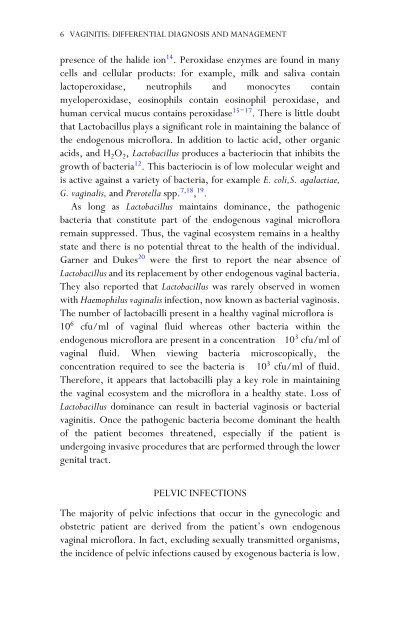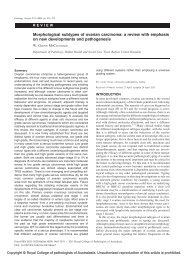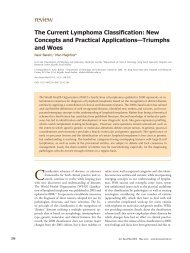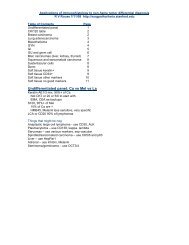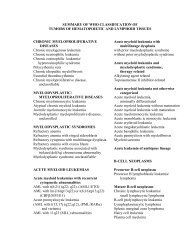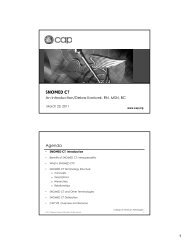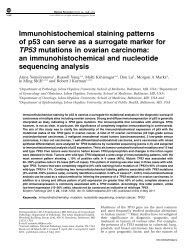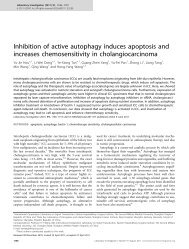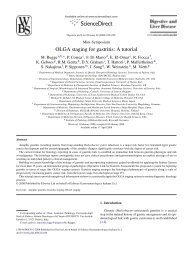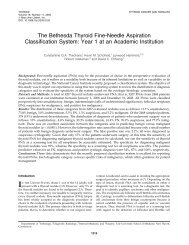Vaginitis: Differential Diagnosis and Management - BPA Pathology
Vaginitis: Differential Diagnosis and Management - BPA Pathology
Vaginitis: Differential Diagnosis and Management - BPA Pathology
- No tags were found...
You also want an ePaper? Increase the reach of your titles
YUMPU automatically turns print PDFs into web optimized ePapers that Google loves.
6 VAGINITIS: DIFFERENTIAL DIAGNOSIS AND MANAGEMENTpresence of the halide ion 14 . Peroxidase enzymes are found in manycells <strong>and</strong> cellular products: for example, milk <strong>and</strong> saliva containlactoperoxidase, neutrophils <strong>and</strong> monocytes containmyeloperoxidase, eosinophils contain eosinophil peroxidase, <strong>and</strong>human cervical mucus contains peroxidase 15−17 . There is little doubtthat Lactobacillus plays a significant role in maintaining the balance ofthe endogenous microflora. In addition to lactic acid, other organicacids, <strong>and</strong> H 2 O 2 , Lactobacillus produces a bacteriocin that inhibits thegrowth of bacteria 12 . This bacteriocin is of low molecular weight <strong>and</strong>is active against a variety of bacteria, for example E. coli,S. agalactiae,G. vaginalis, <strong>and</strong> Prevotella spp. 7,18 , 19 .As long as Lactobacillus maintains dominance, the pathogenicbacteria that constitute part of the endogenous vaginal microfloraremain suppressed. Thus, the vaginal ecosystem remains in a healthystate <strong>and</strong> there is no potential threat to the health of the individual.Garner <strong>and</strong> Dukes 20 were the first to report the near absence ofLactobacillus <strong>and</strong> its replacement by other endogenous vaginal bacteria.They also reported that Lactobacillus was rarely observed in womenwith Haemophilus vaginalis infection, now known as bacterial vaginosis.The number of lactobacilli present in a healthy vaginal microflora is ≥10 6 cfu/ml of vaginal fluid whereas other bacteria within theendogenous microflora are present in a concentration ≤ 10 3 cfu/ml ofvaginal fluid. When viewing bacteria microscopically, theconcentration required to see the bacteria is ≤ 10 3 cfu/ml of fluid.Therefore, it appears that lactobacilli play a key role in maintainingthe vaginal ecosystem <strong>and</strong> the microflora in a healthy state. Loss ofLactobacillus dominance can result in bacterial vaginosis or bacterialvaginitis. Once the pathogenic bacteria become dominant the healthof the patient becomes threatened, especially if the patient isundergoing invasive procedures that are performed through the lowergenital tract.PELVIC INFECTIONSThe majority of pelvic infections that occur in the gynecologic <strong>and</strong>obstetric patient are derived from the patient’s own endogenousvaginal microflora. In fact, excluding sexually transmitted organisms,the incidence of pelvic infections caused by exogenous bacteria is low.


